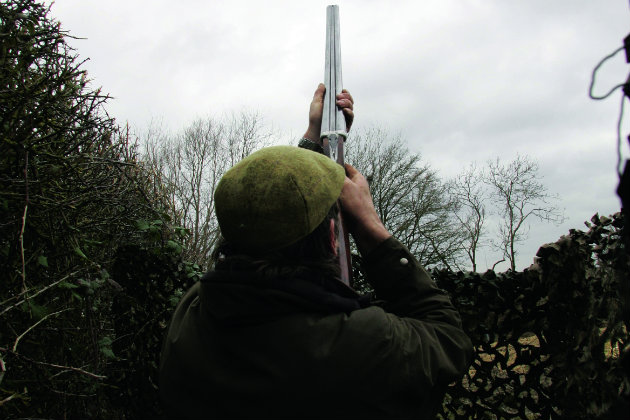When pigeons come home to roost
Handy hints for successful roost shooting
Win CENS ProFlex DX5 earplugs worth £1,149 – enter here
Snap shooting is often the key when roost shooting pigeon, says coach Mark Russell.

Shooting as many pigeons as possible over the next few weeks is crucial as they’ll soon be in breeding mode, so every bird you shoot now means one less on the crops later in the year.
You’ll be doing every farmer in the country a favour and you’ll also have some decent sport.
The sheer unpredictability of a pigeon’s flight pattern, coupled with its natural speed and ability to veer off like lightning will sharpen up your shooting skills no end.
Pigeons can be tricky targets at the best of times and as no one wants to prick live quarry if they can help it, is it possible to improve your pest control kill rate?
To help you improve we’re going to look at pigeon-type targets here; how to nail them when they’re coming in to roost, but also include a few snap shooting techniques needed for the typical second barrel bird.
View this post on Instagram
Pigeons can be most elusive but their Achilles heel is when they commit themselves to land. That is when they’re feathering back. Their wings are in reverse thrust mode and they’re at the most vulnerable.
For brief moments they’re hanging in the air, almost crow-like, before they slide into the branches of the trees. It’s at this point when they’re most shootable, so here are a few pointers to improve your kill to cartridge ratio.
Do your preparation at the clay ground by practising on typical crow type targets.
Try and make the situation as realistic as possible. Stay comfortable. Keep the stock just out of the pocket of your shoulder with the muzzles of the gun pointing at, or just in front of the expected pick up point.
You know roughly where the birds will appear, so keep the barrels just below the flight line – to make sure you don’t obscure your view of the bird – before you raise the gun to your shoulder.
When the target seems to be hovering quite nicely on the bead of the barrel pull the trigger.
Take the bird too soon – when it’s still a good distance away from the stand – and it might simply breeze through the shot pattern.
Trying to kill it too late will often mean the bird is no longer under power and it’s starting to drop very quickly indeed.
When your gun mounting technique is correct every time, effective snap shooting comes about predominately by timing. The more you practice, the more you’ll get a feel for a target and you’ll get to know instinctively the precise moment to pull the trigger.
What you must never do is hesitate. Whenever I see this happening it’s always because the shooter is trying extra hard to ‘make sure’ he hits the bird.
By trying to improve the shot he’s undoing everything that his instincts have told him.
In these situations as soon as you start thinking about what you’re doing (or trying to achieve) you’re almost certain to miss the bird.
Here are a couple of fun exercises you can do on the clay ground to help you practise authentic snap shooting.
The trickiest pigeon shot is often the second barrel, where the missed bird has veered away, or the second of a double has heard the bang and flown off.
This going away target often demands instinctive ‘snap shooting’ and one of the best ways to practice this is with a change of discipline.
Why not have a few rounds of automatic ball trap or universal trench?
The beauty of both these disciplines is that the birds are released at random trajectories – angles and heights – from any one of five traps in the case of universal trench.
It would be a real sharpener for your shooting skills.
To make it even more realistic try and keep the gun down before you call for the clay.
Importantly, don’t worry too much if you miss more than you hit in the beginning – it’s the experience that counts.
Handy hints for successful roost shooting
There is no substitute for regular gun mounting practise to achieve a smooth, fluent and efficient mount — bringing the…
The season was drawing to an end when I received a call from Shooting Times Editor Patrick Galbraith. Patrick mentioned…
Although sharpening your reflexes and utilising instinct can definitely improve your hit rate, no shooter can rely on this alone.
There’s never been a substitute for perfecting a decent shooting technique.
So make sure your gun fits you properly and you mount it correctly every time.
Ensure your stance – moving your feet if necessary – is correct for the target and your swing is smooth.
Then let instinct, coupled with your mental library of sight pictures take control when you pull the trigger.
Get the latest news delivered direct to your door
Discover the ultimate companion for field sports enthusiasts with Shooting Times & Country Magazine, the UK’s leading weekly publication that has been at the forefront of shooting culture since 1882. Subscribers gain access to expert tips, comprehensive gear reviews, seasonal advice and a vibrant community of like-minded shooters.
Save on shop price when you subscribe with weekly issues featuring in-depth articles on gundog training, exclusive member offers and access to the digital back issue library. A Shooting Times & Country subscription is more than a magazine, don’t just read about the countryside; immerse yourself in its most authoritative and engaging publication.

